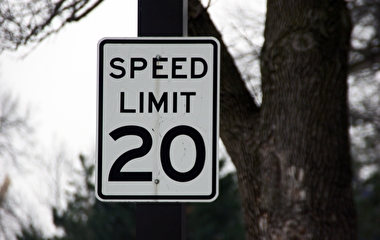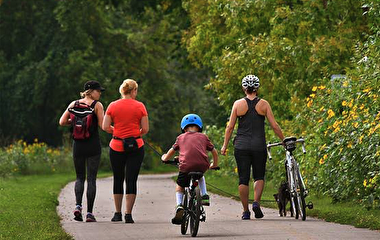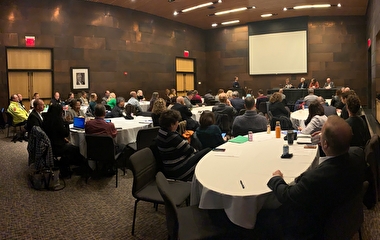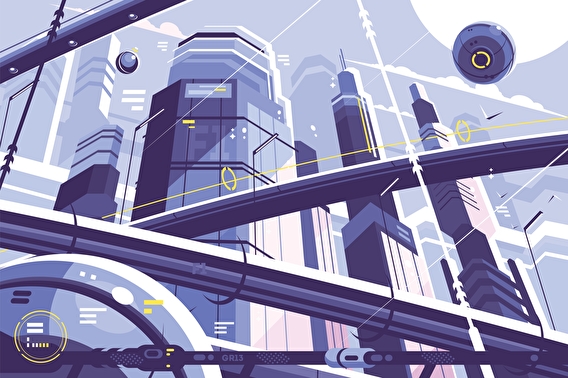
Since the early days of the automobile, transportation technology and innovation in the US have been steered not by public need but by business interests, according to Peter Norton, the 2022 CTS Transportation Research Conference opening speaker. With the next wave—vehicle automation—at hand, can technology finally deliver on the long-promised transportation utopia?
Norton, an associate professor of history from the University of Virginia, opened his talk with a historical perspective on the adoption of automobiles. “We today are the heirs of a revolution in our sense of what streets are for, who belongs in them, how people should get around, and what’s public and what’s private in our mobility sector,” he said. “It’s a revolution that is practically unknown.”
In the early 1900s, transportation was a mix of pedestrians, bicyclists, street cars, trolleys, and other modes. Cars were just beginning to become more prevalent, and so were automobile-related crashes and deaths. This, in turn, prompted public concern, such as calls for stricter speed limits.
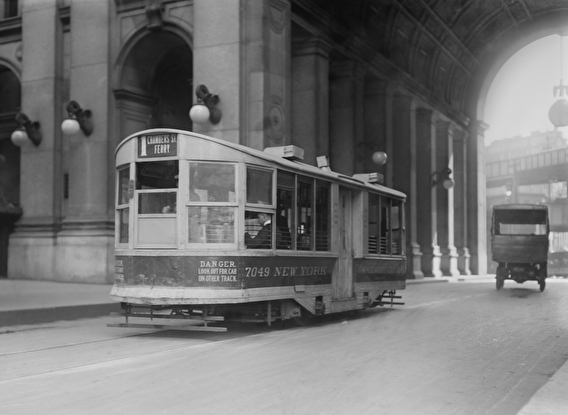
The automobile industry, Norton said, saw this as a threat to business and began to push back. A 1922 editorial published in Engineering News Record called for a “radical revision” in which the conflicts between pedestrians and vehicles would be solved by making streets a place where cars are the default—not people.
Companies painted an optimistic picture of a car-dependent future. In 1939, for example, General Motors created the “Futurama” exhibit at the New York World’s Fair, selling a vision of what the year 1960 would look like if every household had a car.
These and similar tactics worked—and car dependency became the norm. Interstates were created as car-only corridors, and street safety became the responsibility of pedestrians rather than an assumed right.
This changed how streets and cities were built. “It’s not that hard to realize that if you funnel unlimited numbers of cars into a city, you have to make room for [them],” Norton said. “You have to erase most of the urban fabric just to store the cars.”
Then, in the 1990s, “smart” technology rose to prominence on the heels of the Gulf War and was touted as the solution that would reduce or eliminate crashes, emissions, and congestion. More recently, automation is following a similar path.
The very concept of innovation, Norton said, tends to be oriented exclusively toward high-tech solutions. The technology necessary for a “car paradise” with zero crashes, zero emissions, and zero congestion is always just a little out of reach, keeping the consumer always wanting more. “You’re being told what your future is going to be by people who make cars and make the tech that supports the cars,” he said.
While high-tech is a useful tool, Norton concluded, it needs to be paired with other social innovations—and transportation should be seen as a public service for the good of all.
Following Norton’s presentation, three panelists discussed his views and gave their perspectives on the role of technology.
Ginny Crowson, director of MnDOT’s Connected and Automated Vehicles (CAV) Office, agreed with Norton that automation needs to be regarded as a tool—not a complete solution. “I think it’s our collective job to recognize where technology is the right tool for the right problem,” she said.
MnDOT led a research project—the Med City Mover—that tested and demonstrated the potential of CAV shuttles in Rochester, Minnesota. The agency has also been broadening CAV outreach so that people can better understand the technology and provide more informed feedback, Crowson said.
Thomas Fisher, director of the Minnesota Design Center at the U of M, agreed with Norton that private businesses are driving the transportation landscape. He cited current trends toward on-demand “service companies” such as Uber and Lyft and planning by auto companies to turn transportation into a subscription service.
This could have advantages and drawbacks. On-demand transportation, Fisher said, could reduce the amount of space needed to store cars, since service companies are incentivized to keep their vehicles moving at all times. However, this could lead to overconsumption of travel. Further, this model will likely not serve low-density rural communities as well as it does urban ones. “That is an incredible paradigm shift that we have to come to grips with, and it changes the equity conversation.”
Marc Valencia, vice president of public engagement and communications at New Publica, said his organization has been meeting with communities not usually at the table for discussions of transportation innovation. This includes Black, indigenous, people of color, immigrant, and low-income communities—demographics that profit-driven businesses are typically not incentivized to engage with.
What stood out to Valencia most, he said, is that technology discussions don’t start with people, “especially people who have significant gaps of accessibility [and] affordability.” He also noted that, when asked, people under 25 typically say that they don’t want car-dependent futures.
Fisher saw something similar when the U of M researchers reached out to a community in Minneapolis. “If you actually asked neighborhoods what they want, they don’t want more cars, they don’t want more streets. And it also made us recognize that we’d maybe overbuilt with our street system.”
Writer: Sophie Koch
